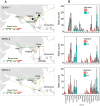Increasing airline travel may facilitate co-circulation of multiple dengue virus serotypes in Asia
- PMID: 28771468
- PMCID: PMC5542384
- DOI: 10.1371/journal.pntd.0005694
Increasing airline travel may facilitate co-circulation of multiple dengue virus serotypes in Asia
Abstract
The incidence of dengue has grown dramatically in recent decades worldwide, especially in Southeast Asia and the Americas with substantial transmission in 2014-2015. Yet the mechanisms underlying the spatio-temporal circulation of dengue virus (DENV) serotypes at large geographical scales remain elusive. Here we investigate the co-circulation in Asia of DENV serotypes 1-3 from 1956 to 2015, using a statistical framework that jointly estimates migration history and quantifies potential predictors of viral spatial diffusion, including socio-economic, air transportation and maritime mobility data. We find that the spread of DENV-1, -2 and -3 lineages in Asia is significantly associated with air traffic. Our analyses suggest the network centrality of air traffic hubs such as Thailand and India contribute to seeding dengue epidemics, whilst China, Cambodia, Indonesia, and Singapore may establish viral diffusion links with multiple countries in Asia. Phylogeographic reconstructions help to explain how growing air transportation networks could influence the dynamics of DENV circulation.
Conflict of interest statement
The authors have declared that no competing interests exist.
Figures






Similar articles
-
Worldwide spread of Dengue virus type 1.PLoS One. 2013 May 13;8(5):e62649. doi: 10.1371/journal.pone.0062649. Print 2013. PLoS One. 2013. PMID: 23675416 Free PMC article.
-
Evolutionary history and spatiotemporal dynamics of dengue virus type 1 in Asia.Infect Genet Evol. 2013 Jun;16:19-26. doi: 10.1016/j.meegid.2013.01.013. Epub 2013 Feb 6. Infect Genet Evol. 2013. PMID: 23395769
-
Air travel is associated with intracontinental spread of dengue virus serotypes 1-3 in Brazil.PLoS Negl Trop Dis. 2014 Apr 17;8(4):e2769. doi: 10.1371/journal.pntd.0002769. eCollection 2014 Apr. PLoS Negl Trop Dis. 2014. PMID: 24743730 Free PMC article.
-
Unraveling Dengue Virus Diversity in Asia: An Epidemiological Study through Genetic Sequences and Phylogenetic Analysis.Viruses. 2024 Jun 28;16(7):1046. doi: 10.3390/v16071046. Viruses. 2024. PMID: 39066210 Free PMC article. Review.
-
Global spread of dengue virus types: mapping the 70 year history.Trends Microbiol. 2014 Mar;22(3):138-46. doi: 10.1016/j.tim.2013.12.011. Epub 2014 Jan 24. Trends Microbiol. 2014. PMID: 24468533 Free PMC article. Review.
Cited by
-
Increasing Dengue Burden and Severe Dengue Risk in Bangladesh: An Overview.Trop Med Infect Dis. 2023 Jan 3;8(1):32. doi: 10.3390/tropicalmed8010032. Trop Med Infect Dis. 2023. PMID: 36668939 Free PMC article. Review.
-
The epidemiological characteristics of dengue in high-risk areas of China, 2013-2016.PLoS Negl Trop Dis. 2021 Dec 20;15(12):e0009970. doi: 10.1371/journal.pntd.0009970. eCollection 2021 Dec. PLoS Negl Trop Dis. 2021. PMID: 34928951 Free PMC article.
-
Assessing the impact of COVID-19 border restrictions on dengue transmission in Yunnan Province, China: an observational epidemiological and phylogenetic analysis.Lancet Reg Health West Pac. 2021 Aug 20;14:100259. doi: 10.1016/j.lanwpc.2021.100259. eCollection 2021 Sep. Lancet Reg Health West Pac. 2021. PMID: 34528006 Free PMC article.
-
In Silico Comparative Analysis of Predicted B Cell Epitopes against Dengue Virus (Serotypes 1-4) Isolated from the Philippines.Vaccines (Basel). 2022 Aug 5;10(8):1259. doi: 10.3390/vaccines10081259. Vaccines (Basel). 2022. PMID: 36016147 Free PMC article.
-
Resurgence of Dengue Virus Serotype 2: Findings from the 2023 Bangladesh Outbreak.Am J Trop Med Hyg. 2024 Jul 9;111(3):617-621. doi: 10.4269/ajtmh.24-0229. Print 2024 Sep 4. Am J Trop Med Hyg. 2024. PMID: 38981496
References
-
- Bhatt S, Gething PW, Brady OJ, Messina JP, Farlow AW, et al. (2013) The global distribution and burden of dengue. Nature 496: 504–507. doi: 10.1038/nature12060 - DOI - PMC - PubMed
-
- Brady OJ, Gething PW, Bhatt S, Messina JP, Brownstein JS, et al. (2012) Refining the global spatial limits of dengue virus transmission by evidence-based consensus. PLoS Negl Trop Dis 6: e1760 doi: 10.1371/journal.pntd.0001760 - DOI - PMC - PubMed
-
- Luz PM, Vanni T, Medlock J, Paltiel AD, Galvani AP (2011) Dengue vector control strategies in an urban setting: an economic modelling assessment. Lancet 377: 1673–1680. doi: 10.1016/S0140-6736(11)60246-8 - DOI - PMC - PubMed
-
- Guzman MG, Harris E (2015) Dengue. Lancet 385: 453–465. doi: 10.1016/S0140-6736(14)60572-9 - DOI - PubMed
-
- Raghwani J, Rambaut A, Holmes EC, Hang VT, Hien TT, et al. (2011) Endemic dengue associated with the co-circulation of multiple viral lineages and localized density-dependent transmission. PLoS Pathog 7: e1002064 doi: 10.1371/journal.ppat.1002064 - DOI - PMC - PubMed
MeSH terms
Substances
Grants and funding
LinkOut - more resources
Full Text Sources
Other Literature Sources
Medical

